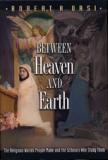Pray for Us'
Robert A. Orsi, Harvard Divinity School’s Charles Warren Professor of the History of Religion in America, takes a complex approach to his own religion and academic disciplines, drawing from his Italian-American family history to illustrate how mid-20th-century Catholics in the United States reacted to changes in their social and ecclesial worlds by redefining their relationship to the sacred. For many of those Catholics, the Second Vatican Council produced an upheaval in their trusted childhood assumptions about the shape of the sacred, about the language of prayers and the sacred presences that each believer summoned, calling on guardian angels, patron saints, the Blessed Mother or St. Jude to intervene when facing hardship.
Balancing historical, archival and personal evidence in a rare style of historical auto-ethnography to study religious intimacy in fresh and intellectually satisfying ways, Orsi takes readers more deeply into his theoretical and conceptual levels of argument by introducing them to his uncle Sal and his grandmother in deeply sympathetic, chapter-length studies. And in the two chapters where he is a nonparticipant observer, we meet devotees of Mary and St. Jude. At the outset Orsi demonstrates the deft handling of archival evidence that readers may expect throughout the book by introducing his mother, who keeps a set of memorial prayer cards of Jesuits who had died years ago, printed by the order to be distributed at the time of their funerals. There were also cards for people she had known during the many years she worked at Fordham University, worn at the edges from habitual use. She takes them out of her handbag bundled in a colored rubber band and arranges them on the table in a kind of celestial solitaire, according to Orsi; these are her friends in heaven who have never let her down.
In Between Heaven and Earth Orsi has rewritten previously published studies to demonstrate his thesis about the intersubjectivity of relationships in a network that defines religious practices. In the first chapter, the author’s Uncle Sal provides evidence of the ambivalent attitudes in the church toward the disabled as fortunate unfortunates whose physical suffering was traditionally thought to have redemptive power. In the second chapter Orsi explores Marian devotional habits and the iconic media of presence found by believers in holy cards, prayer beads, relics, statues and images, blessed oils and waters. Such presence involving the Madonna wields an ideological meaning so powerful that, he explains, it can cause social disruption.
This argument is amplified in the third chapter, where Orsi writes about how children imagine sacred presences as real, and how their spiritual beliefs are embodied in the material. Readers are left to connect the first and third chapters, the first about suffering and the third about vulnerability, especially vis-à-vis the sexual abuse crises in the Catholic Church. But there is much here for thoughtful reflection about power and perceptions of the vulnerable, as well as the theological importance of suffering.
Next the author turns to how his bereaved grandmother prayed to St. Gemma Galgani, and explores how domestic hagiography grows from relationships developed between humans and saints in times of crisis and emotional need. The chapter on St. Jude moves beyond fieldwork in Chicago, which in itself is a fascinating study, to a discussion of the dimensions of the genre within which he writes, a historical, autobiographical, ethnographic account of the differences between subject and researcher. The problem of sympathy and balance is paramount; the researcher can neither judge nor promote a point of view.
In his final chapter, Orsi uses fieldwork on studying Appalachian snake handling to further illustrate his points about the difficulties a researcher faces when studying faith practices that seem strange. The enthnographic historian walks a fine line between proximity and distance, understanding and judgment. This inscribes for the Catholic intellectual a critical boundary between good and bad religions and the protocols that discredit autobiographical experience.
Historically, Orsi observes, studies of religion in America rejected the work of seminaries and schools of theology. So admitting that one is a believer can set one up for criticism from both the religious right, which puts most value on the literal, and the academic left, which values the objective and rational. Between Heaven and Earth is a good academic paradigm for the Buddhist Middle Way: Orsi is both passionate and dispassionate about Catholicism, intimate and analytic, an insider and an outsider.
Many rigorous scholars shy away from discussing mystery. The devout are said to engage in meaning making, and to enact religious materiality. Orsi explains that religion is intersubjective; in other words, faith is a network of relationships between the present and the past. As his personal, historical and archival evidence demonstrate, in each family’s life there is struggle enough and the strength to bridge the distance between heaven and earth.
This is a memorable book, both for the story of Orsi’s family, in which he situates historical and cultural practices, and for the intellectual challenge his work represents to the interdisciplinary study of religions. Between Heaven and Earth is a classic.
This article also appeared in print, under the headline “Pray for Us',” in the May 2, 2005, issue.








